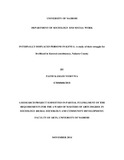| dc.description.abstract | Kenyans have been experiencing inter-ethnic conflicts for the past several years. The first ethnic
conflicts occurred in the Rif Valley in 1992. Ever since various communities especially those in
this region have been experiencing inter-ethnic conflicts which have led to loss of lives, property
and displacement of households. Such cases have not been experienced not only in Rift valley
but also in various parts of the country. Several households have greatly contributed to the
growth of the economy not only in the study area but also in Kenya as a whole. However the
frequent eruption of inter-ethnic conflicts has rendered their efforts fruitless.
This project focused on internally displaced households and how they struggle for their
livelihood in Kuresoi constituency, Nakuru County. To achieve this, the survey was conducted in
two Internally Displaced Camps namely Kapkembo and Kongasis in Kuresoi constituency where
several households provided information. Probability sampling was used to select IDP
households that provided information using the questionnaires. Non probability sampling was
used to select community leaders, government officials and church leaders who served s key
informants. Non probability sampling was also used to select some of the most affected
households that provided information using focus group discussion.
A structured questionnaire was used for personal interviews, listed discussion topics were used
for an in-depth interview, a focus group discussion guideline was used for focus group
discussions, a checklist was used for observation and a case study conducted on one household.
A total of 63 respondents participated in the research.
Most of the activities were adhered towards the improvement of their living standards. The study
revealed that 44.44% of the households were small scale farmers.
As a source of livelihood, most of them members undertook farming and at the same time other
part time jobs. Women were active participants in self-help groups through which they had been
able to improve the living standards in their homesteads. Whenever there was an outbreak of
inter-ethnic conflicts, most of the farms were left unattended to making their farm products to be
destroyed.
The study found out that inter-ethnic conflicts had negatively affected the participation of
households in livelihood activities. All the respondents were unanimous that the conflicts
negatively affected their livelihood activities. The findings indicated that the time taken before
restoration of peace was long leading to permanent dissolution of livelihood activities like selfhelp
groups.
It was evident that that conflict brought about enmity and suspicion among community
households. The findings also proved that fear and tension in Kuresoi will permanently affect the
relationship among households from the two communities.
The major recommendation was that the government should intensify the efforts in restoration of
peace and unity in the area. Future studies ought to address a permanent solution to inter-ethnic
conflicts in Kuresoi and in the whole country. | en_US |

